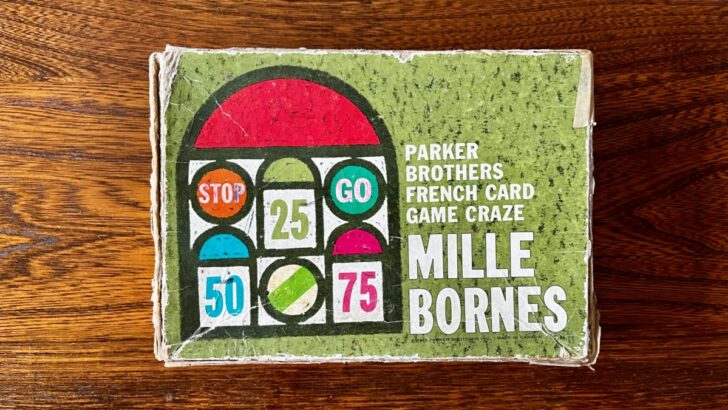Mille Bornes is a classic French card game in which you’re a driver competing to cover the most miles and not so subtly sabotaging the other players. Read our Mille Bornes review to see if this game goes the distance.
Contents
Mille Bornes Overview
Mille Bornes is a card game for 2 to 4 players; typically, players compete against each other, but there are rules for playing a partnership game with 4 or 6 players in teams of 2.
During the game, you’ll play various cards to your personal area to try to “drive” 1000 miles (or more). You can also play cards against your opponents to hinder their progress.
Once a player reaches at least 1000 miles, everyone scores points for the distance they’ve driven and the Safety cards they’ve accumulated along the way. The player with the most points wins.
Mille Bornes Cards
Mille Bornes includes 110 cards that fall into 1 of 4 types: Distance, Hazard, Remedy, or Safety.
Distance Cards
You’ll play Distance cards to your personal area to increase your driving distance, hoping to reach 1000 miles and end the game. Distance cards are numbered “25,” “50,” “75,” “100,” or “200.”
You’ll also score the face value of each of these cards that you’ve played during the game.
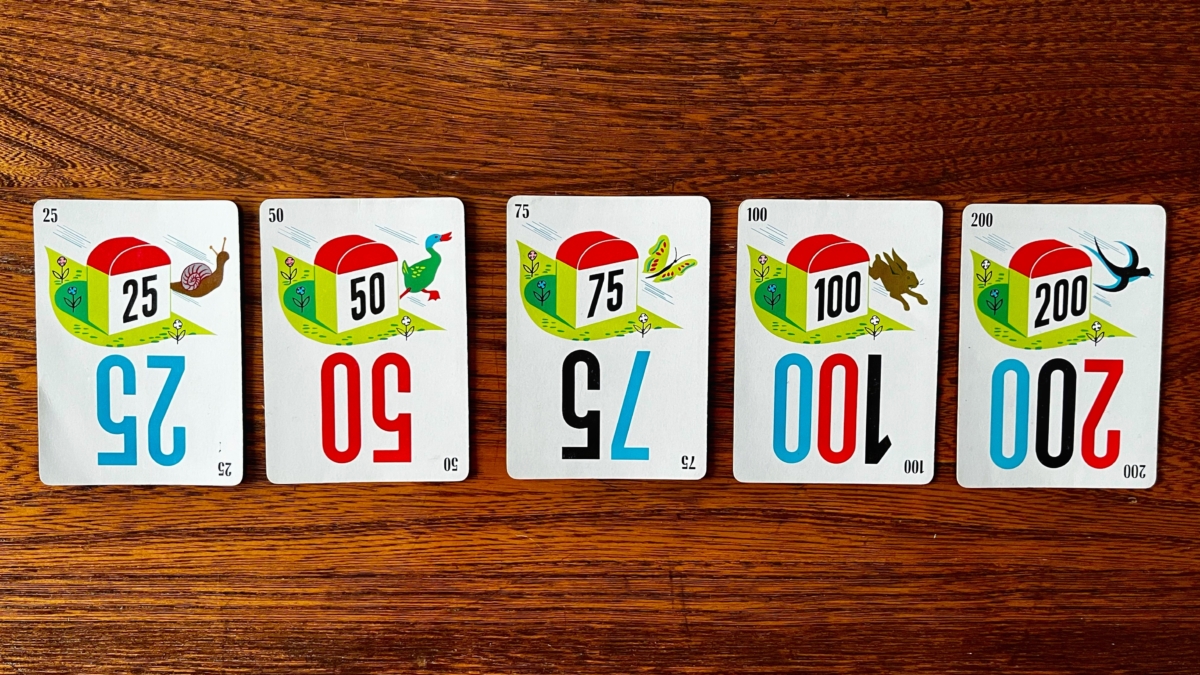
The 5 different Distance cards.
Hazard Cards
There are 5 kinds of Hazard cards: “Stop,” “Speed Limit,” “Out of Gas,” “Accident,” and “Flat Tire.”
You play these cards against other players to hinder their progress in the game — or slow it down, as is the case with the “Speed Limit” card.
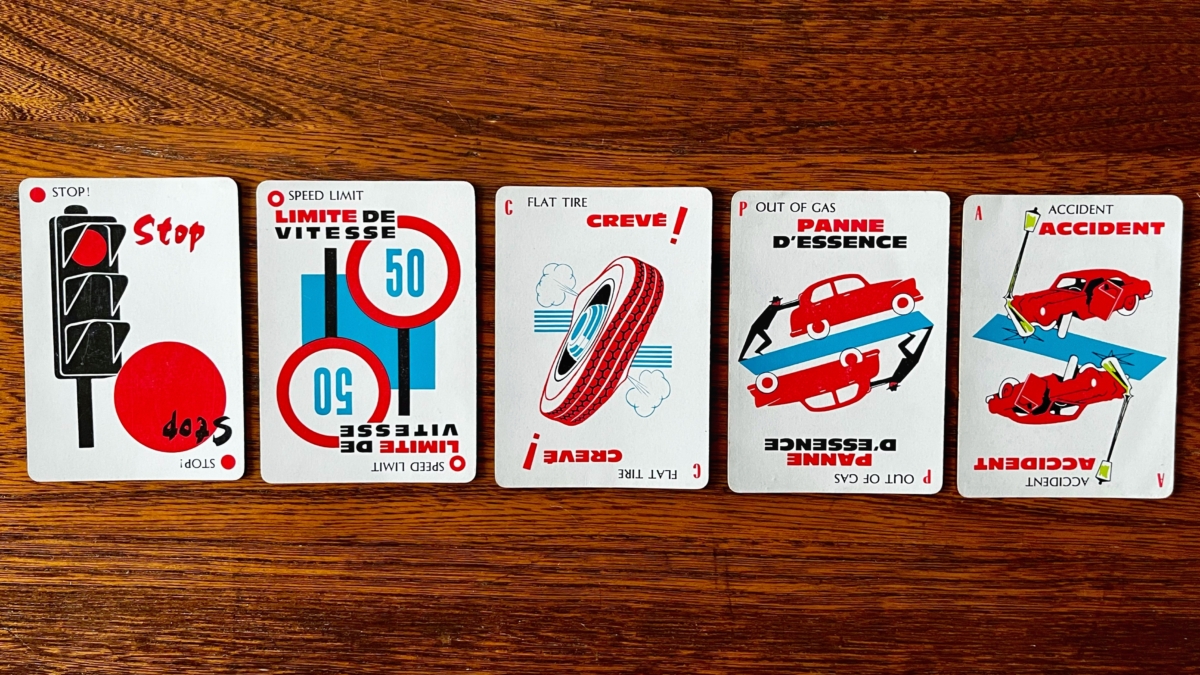
The various Hazard cards in Mille Bornes.
Remedy Cards
Mille Bornes also includes 5 distinct types of Remedy cards. You’ll play these cards to your personal area to fix a Hazard that’s been played against you.
The 5 Remedy cards include: “Drive,” “End of Speed Limit,” “Gas,” “Spare Tire,” and “Repairs.”
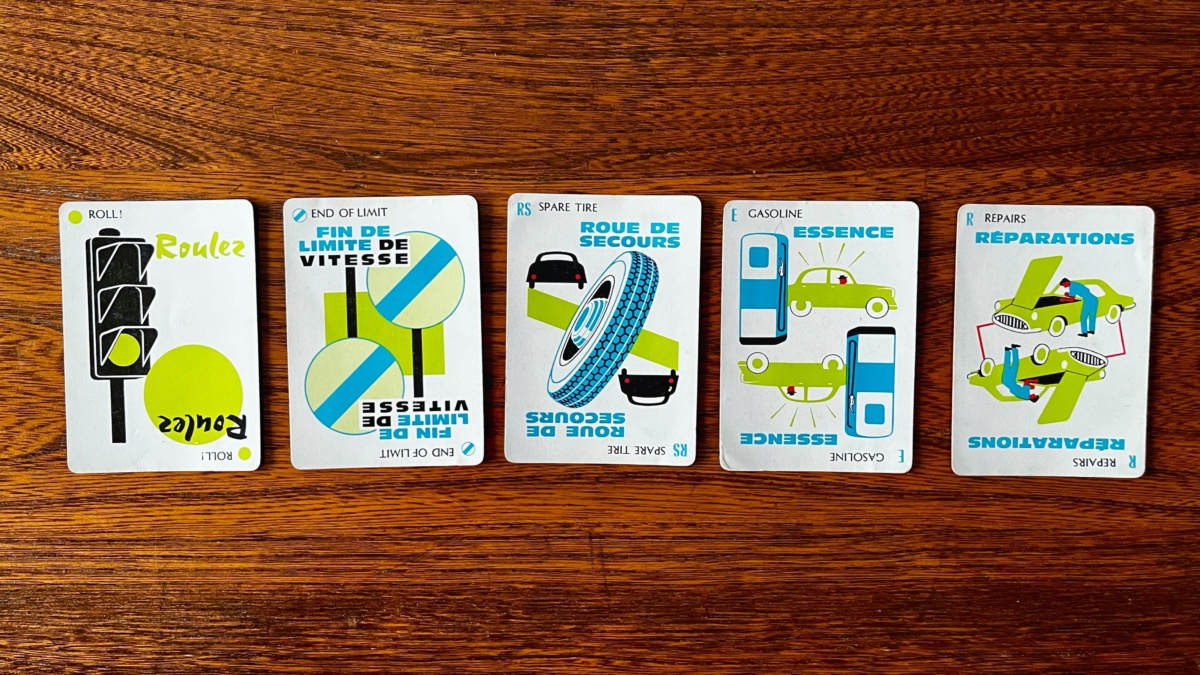
Here are the 5 types of Remedy cards. The green light “Roll!” card is now called “Drive.”
Moreover, the “Drive” card has another function: in order for a player to begin playing Distance cards to their area, they must first play a “Drive” card.
Safety Cards
The last of the Mille Bornes cards are the 4 Safety cards. These cards are preventative measures to protect the person who plays it from specific Hazards.
The “Emergency Vehicle” card lets players ignore “Stop” and “Speed Limit” cards. (It can also replace your initial “Drive” card to get you rolling.)
The “Fuel Truck” card protects against the “Out of Gas” Hazard, while the “Puncture-Proof” card prevents “Flat Tire.”
Lastly, the “Driving Ace” protects a player from the “Accident” Hazard.
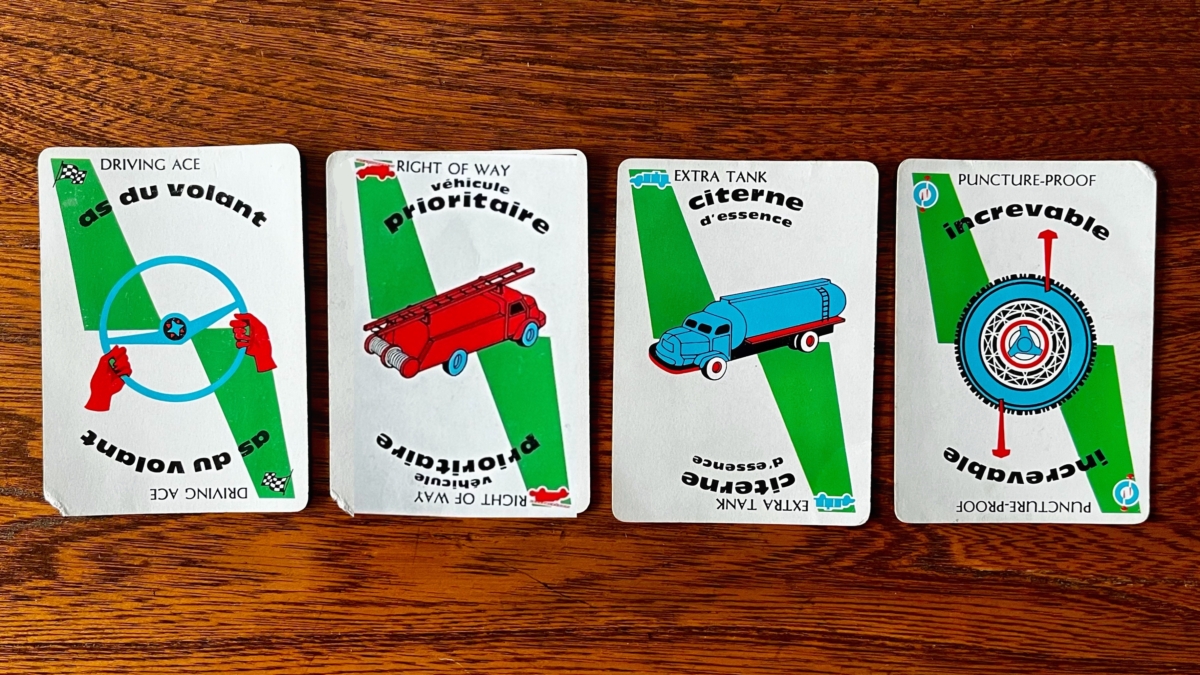
The 4 Safety cards. (Note: The “Right of Way” card has been updated to “Emergency Vehicle” and “Extra Tank” to “Fuel Truck.”)
How To Play Mille Bornes
To begin a game of Mille Bornes, simply shuffle the entire deck and deal 6 cards to each player. The remaining cards form a draw pile for the game.
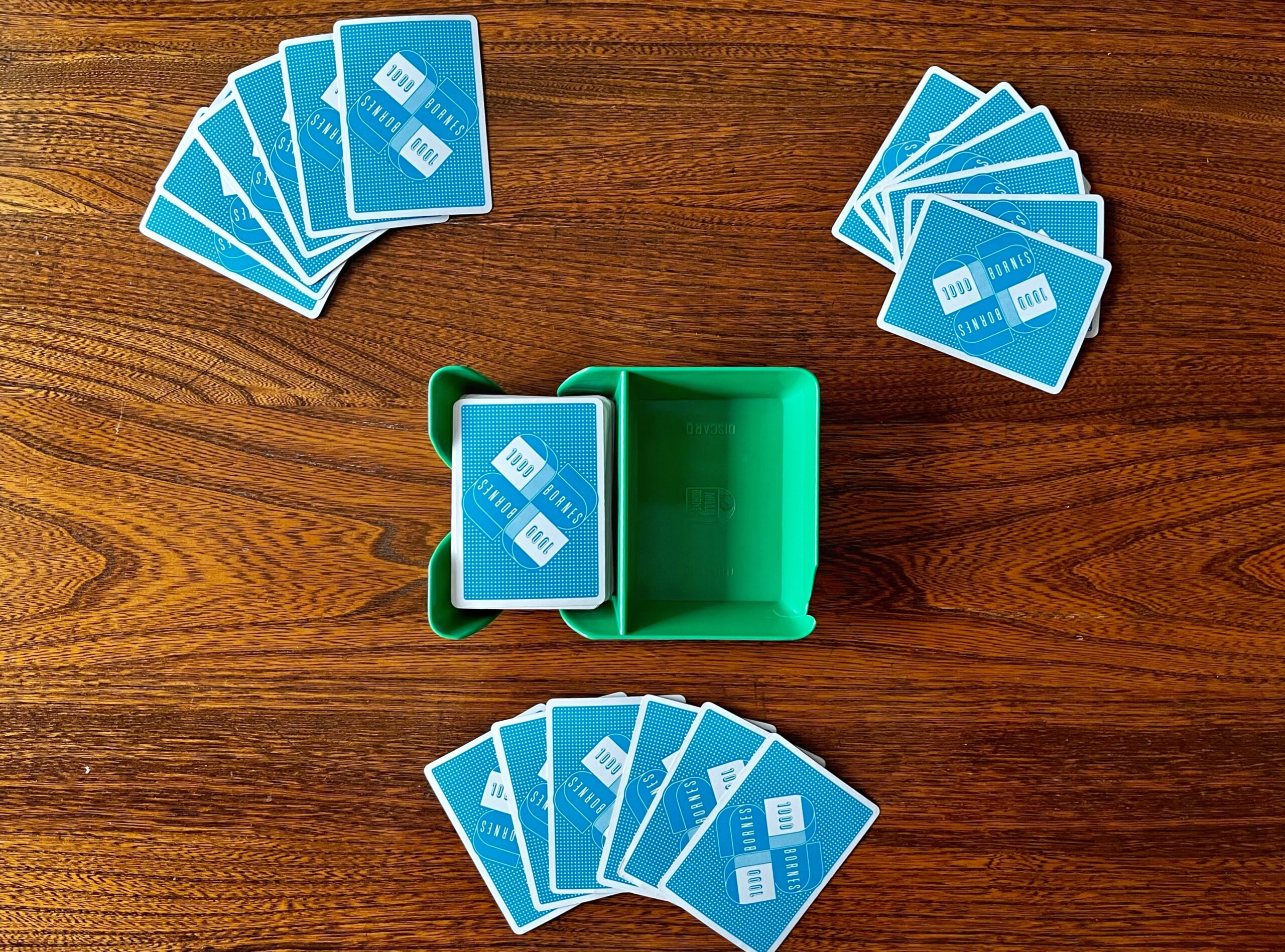
A game of Mille Bornes set up for 3 players.
Player Turn
On your turn, you’ll:
- Draw 1 card from the top of the draw or discard pile, then
- Play 1 card from your hand.
When you play a card, you have 3 options:
- Play to your personal area (your “Driving Zone”),
- Play to an opponent’s Driving Zone, or
- Discard a card.
You may play Distance, Remedy, and Safety cards to your Driving Zone, but Hazard cards are played in an opponent’s.
Driving Zone
Your Driving Zone consists of 4 areas: an area for your Distance cards, Speed Limit pile, Drive pile, and Safety cards.
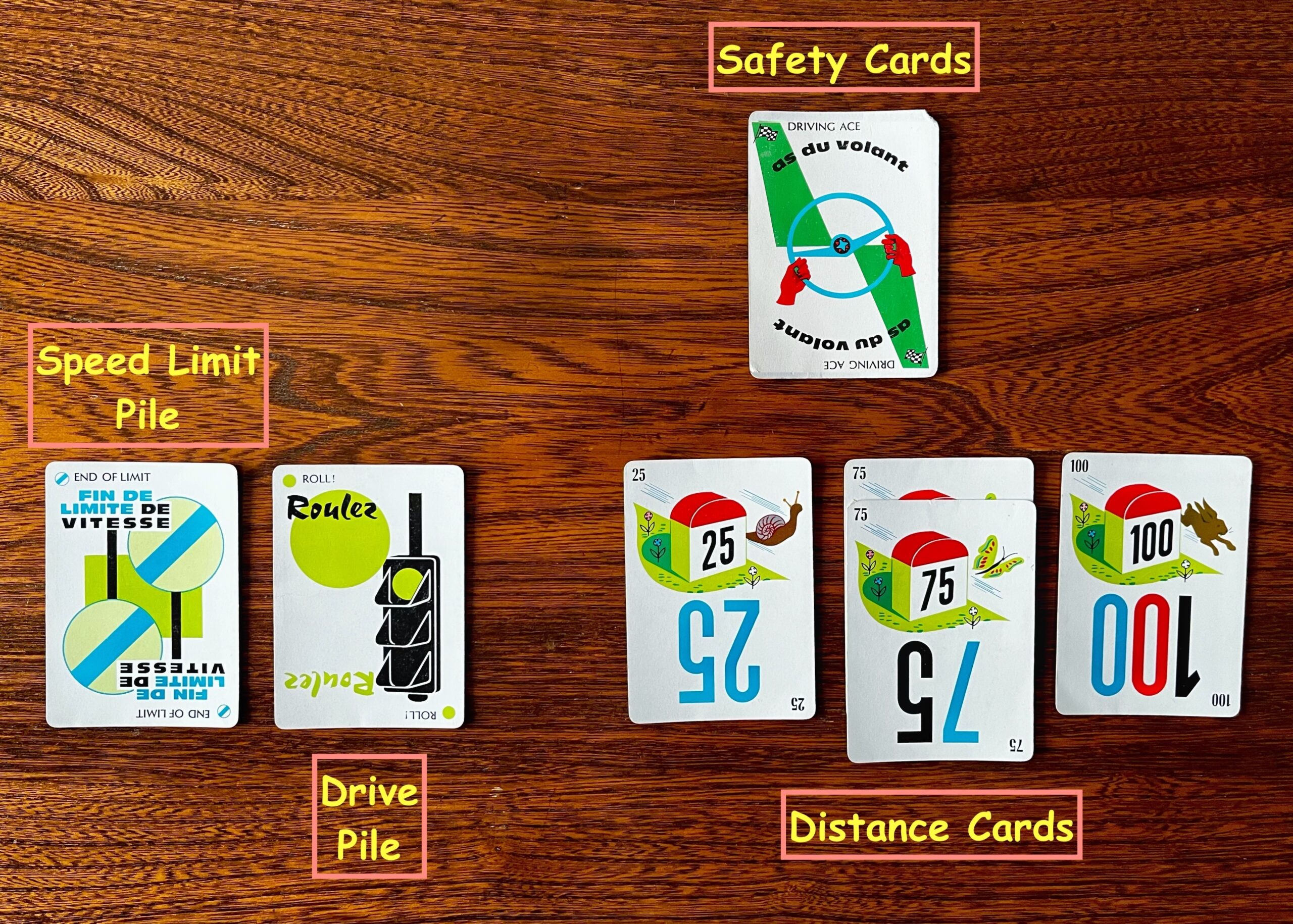
This is what a player’s Driving Zone might look like.
Distance Cards Area
Distance cards are organized by their value so that it’s easy to tell how many miles a player has traveled — at least 1000 is the goal of the game. But you’re never allowed to have more than 2 “200” Distance cards in your Driving Zone.
That’s too reckless.
Speed Pile
Opponents can play “Speed Limit” Hazard cards to your Speed pile. This Hazard, unlike the others, is more of a nuisance than an impediment; you can still play Distance cards, but their value cannot be higher than 50.
Drive Pile
Before you can play any other cards, you must first play to your Drive pile. If no one has played a Hazard card on you, this card must be the “Drive” card.
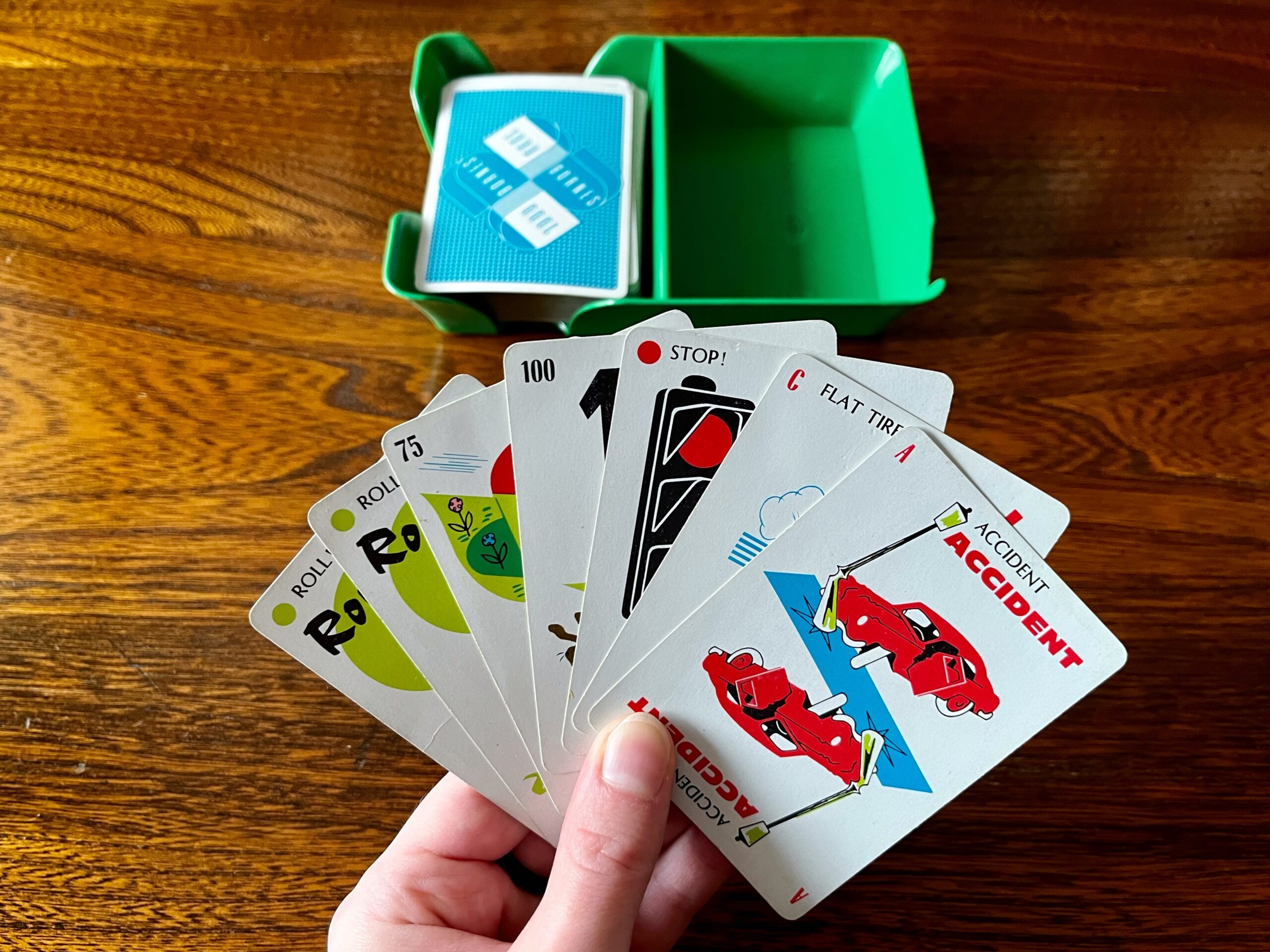
This player drew 1 card and will then play a green light “Drive/Roll!” card to get their game going.
If someone has played a Hazard on your Drive pile, you must play its Remedy. For example, if someone plays the “Accident” Hazard card, you remedy it with “Repairs.”
After you’ve played a Remedy, you don’t need to then play a “Drive” card on a later turn.
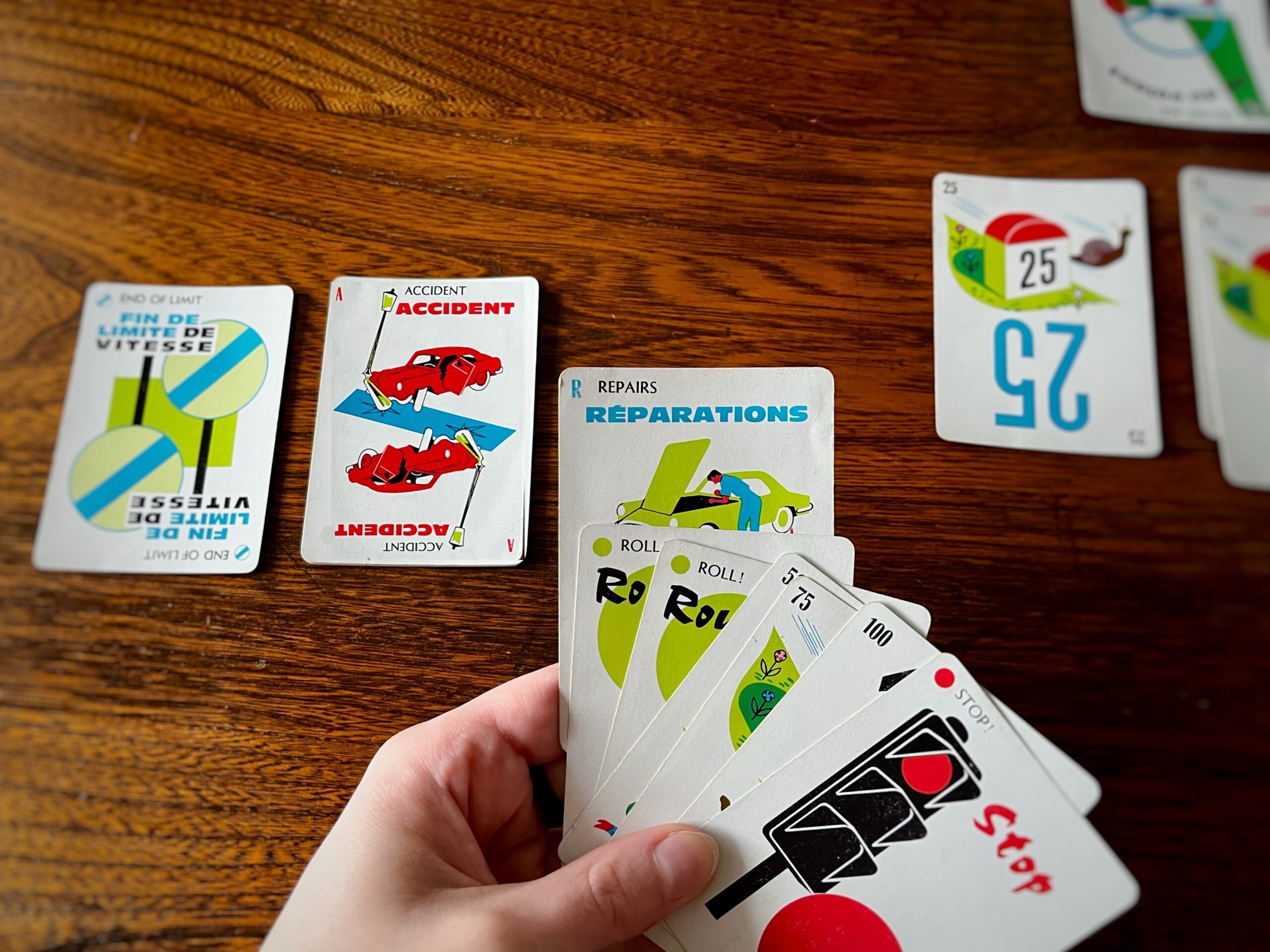
This person can play their “Repairs” card to remedy the “Accident” on their Drive pile.
Once your Drive pile shows a Remedy card, you can play Distance cards or Safety cards to your Driving Zone, or a Hazard card on an opponent’s Speed or Drive pile.
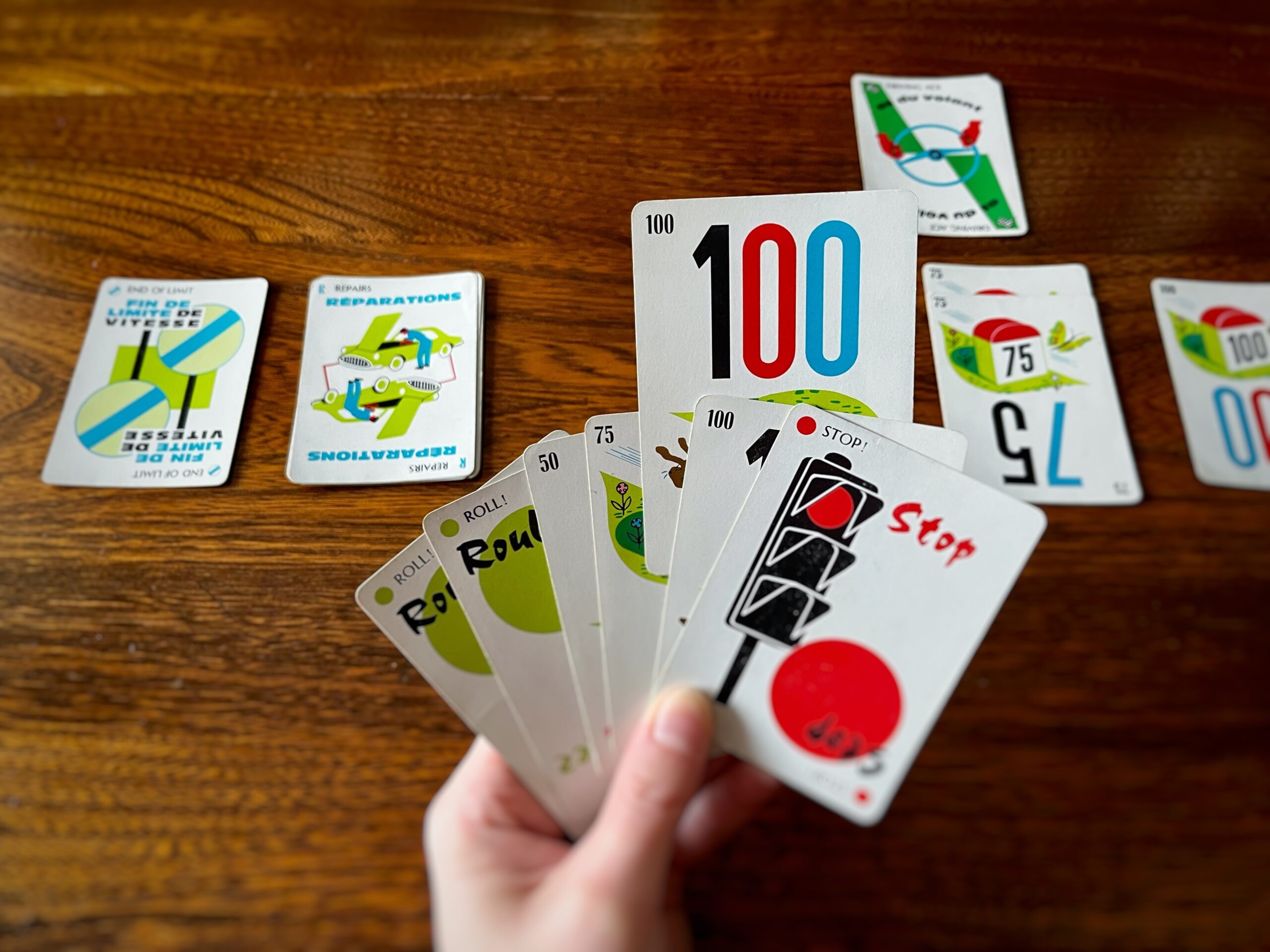
Now that the accident is repaired, this player can play as usual. They’ll choose to play their “100” Distance card.
Playing Safety Cards
There is, however, a rule-breaking Safety card — the “Emergency Vehicle” — that allows you to ignore the requirement of needing a Remedy card on your Drive pile.
You can play it on your turn, and on subsequent turns, you’ll be able to play Distance, Hazard, and other Safety cards.
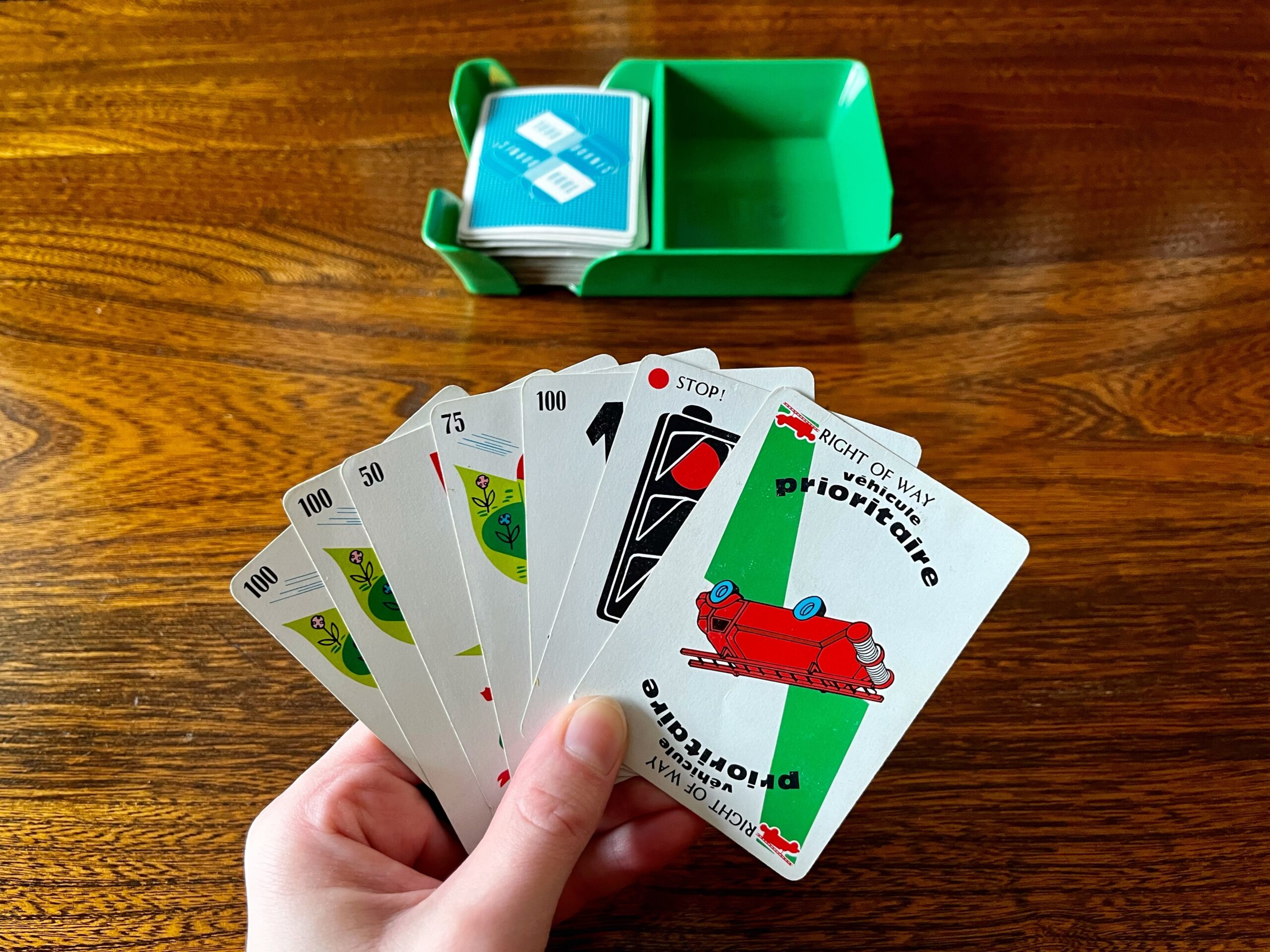
This person can play their “Emergency Vehicle/Right of Way” card on their first turn.
Remember that when a player has a Safety card, no one is allowed to play the corresponding Hazard against them.
For instance, if you’ve played the “Fuel Truck” Safety card, no one can play the “Out of Gas” Hazard against you. (The other Hazards, however, would be fair game.)
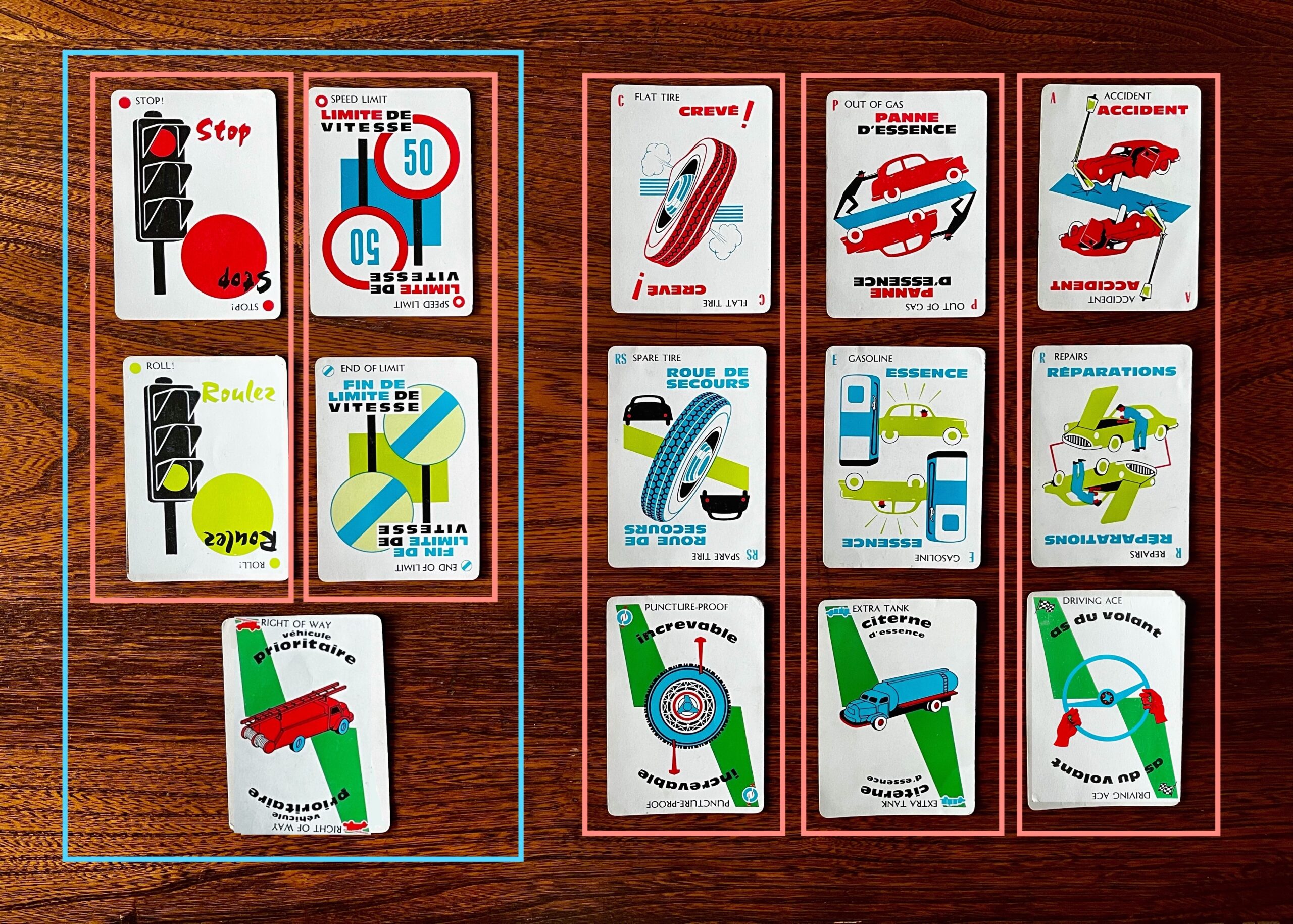
Here are all the Hazard, Remedy, and Safety cards organized by how they interact with one another.
All 4 Safety cards are also special in that after you play one, you get to take another turn right away — drawing a card, then playing 1 from your hand.
And, if Safety cards weren’t powerful enough, there is a way to play one from your hand out of turn.
This move is called a coup fourré (a fencing term that effectively means you outmaneuver your opponent).
Coup Fourré
If an opponent plays a Hazard card on your Drive pile and you have the matching Safety card in hand, you say “Coup fourré” and foil their plans.
The Hazard card they just played is discarded, and you add the Safety card sideways to your Driving Zone.
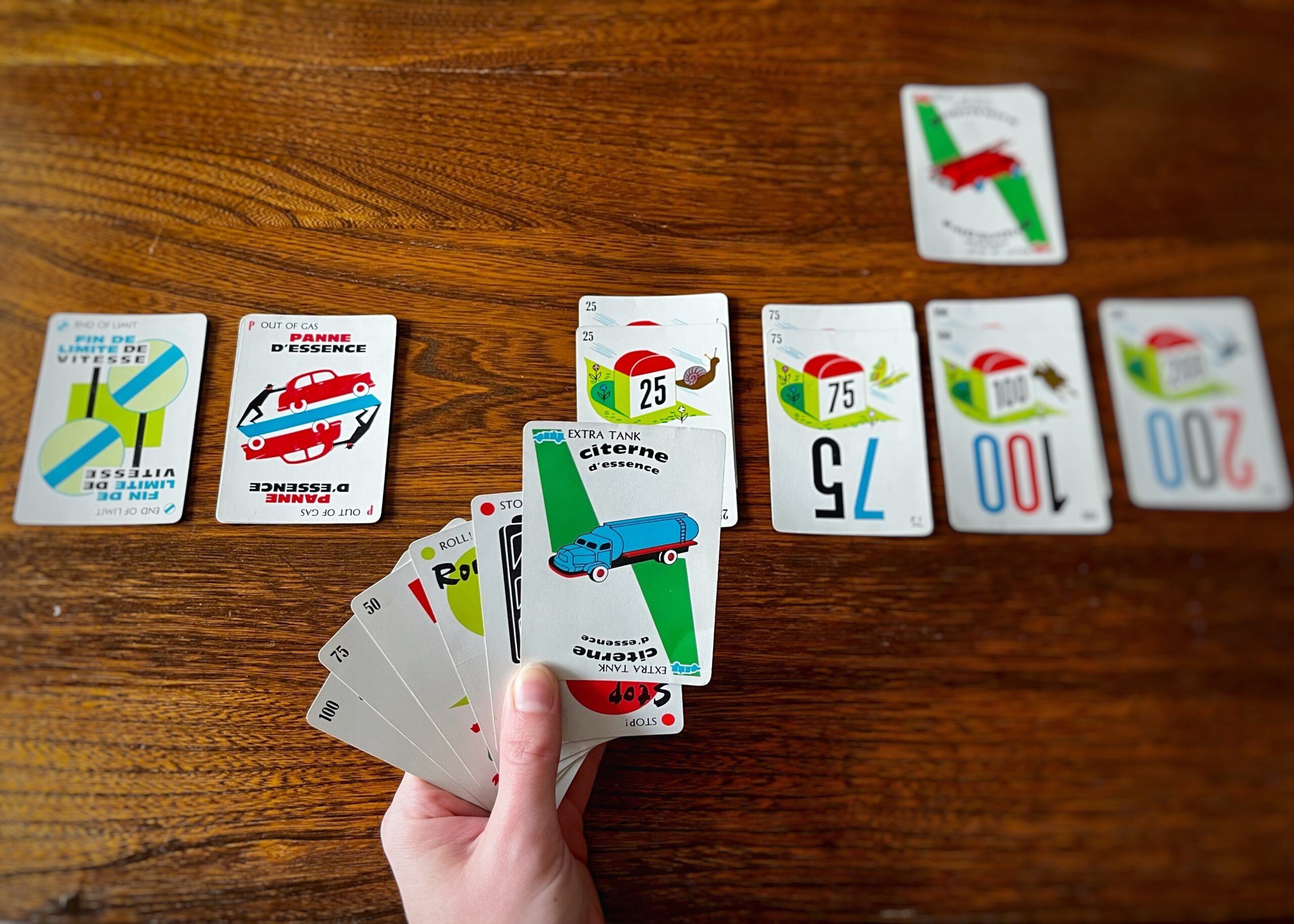
An opponent played the “Out of Gas” Hazard on this player’s Drive pile.
Since they have the corresponding Safety card in their hand, they call out “Coup fourré,” discard the Hazard, and lay the Safety card sideways in their Driving Zone.
Why might you hold on to a card and wait for this moment? Well, you score 100 more points for a coup fourré than you would for playing a Safety card in the usual way on your turn.
You also then take over the course of play because it immediately becomes your turn (since you played a Safety card).
End of the Game
Players continue taking turns — drawing 1 card, playing 1 card — until someone has reached or exceeded 1000 miles worth of Distance cards.
Then, players tally their scores for the cards in their Driving Zone as follows:
- Distance cards are worth their face value.
- Each Safety card is 100 points.
- Each coup fourré Safety card is worth 200 points.
The player with the most points wins.
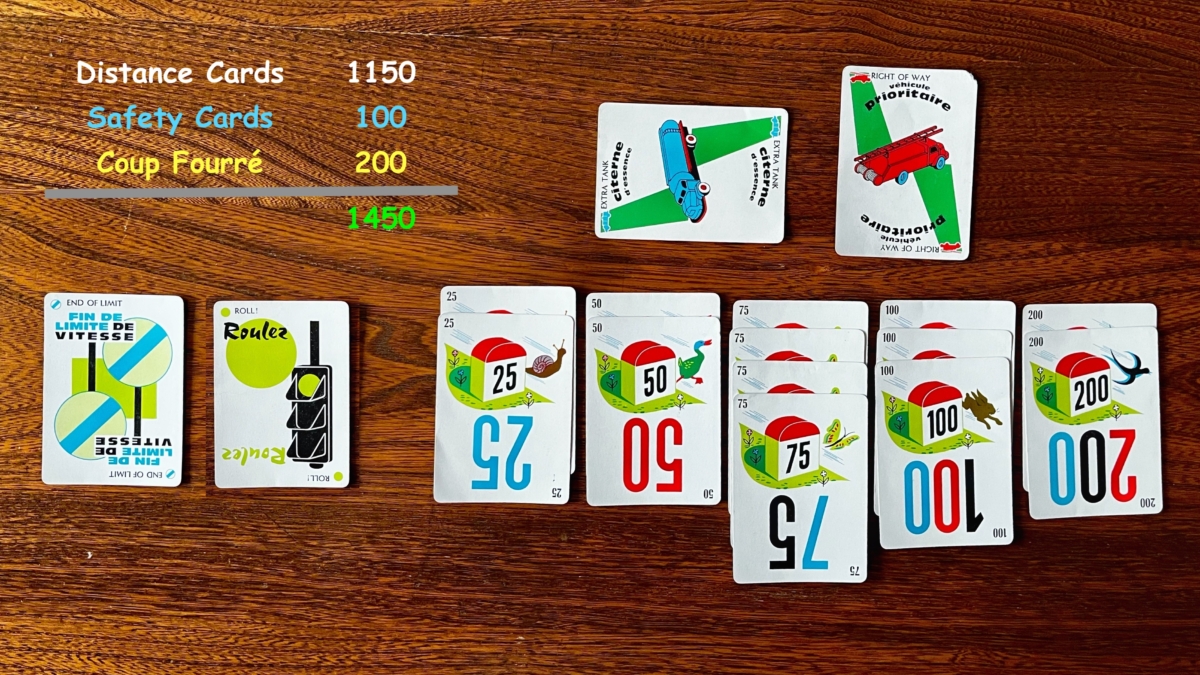
This player’s final score is 1450 (1150 for the Distance cards they played, 100 for their “Emergency Vehicle” Safety card, and 200 for their “Fuel Truck” coup fourré).
Mille Bornes Review
Mille Bornes is an extremely aggressive card game; while your goal is technically to reach 1000 miles worth of Distance cards, it feels like your real goal is to be the biggest pest to your opponents.
You feel this negative player interaction almost immediately as you’re hit with Hazard card after Hazard card.
Mille Bornes is also super dependent on the luck of the draw. Whether it is the person who draws 2 Safety cards in their starting hand or the one who can’t seem to draw the Remedy card they need, it’s hard not to get frustrated with the high level of randomness in the game.
Comparison to Original Rules
The latest rules for Mille Bornes are vastly different from the version of the game own — and, frankly, I hate playing with them.
Mille Bornes has always been a game I enjoyed playing with the right people when we were in the right mood.
The new rules compound everything I don’t like about the original game and make for a truly unenjoyable gaming experience.
Luck has always been a problem in Mille Bornes. However, the original version was played in rounds, not a one-shot game.
One player might get lucky and score big points in a single round, but the odds were also likely to swing your way at least once in a subsequent round.
There were also more ways to score points. The new rules may be more streamlined, but the original scoring introduced a level of strategy and excitement that’s now missing.
There were ways to push your luck or try to outplay your opponents that made your choices and the gameplay far more interesting.
The latest rulebook is also quite a mess; it streamlines MilleBornes’ rules but leaves out key gameplay details.
The original rulebook was not ideal in all its verbosity, but at least you could more easily grasp the game’s concepts.
You’d think, too, that with all the time spent completely making over Mille Bornes, they might have adjusted the overpowered “Emergency Vehicle” card to make it comparable to other Safety cards.
The new rules aren’t all bad; they have added the option to draw from the discard pile, which adds a compelling point of tension to the game as you have to be more careful with what you discard.
Final Thoughts
Mille Bornes is a confrontational game that, with its new ruleset, doesn’t leave much room for strategy of any sort.
It is not one I would recommend seeking out, even for players who enjoy a high level of negative player interaction.
You might also be interested in the following:

